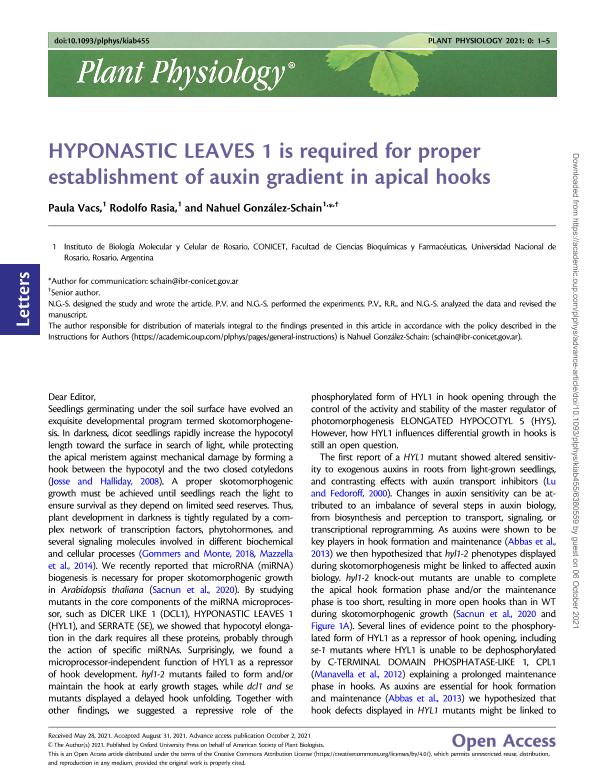Artículo
Hyponastic leaves 1 is required for proper establishment of auxin gradient in apical hooks
Fecha de publicación:
10/2021
Editorial:
American Society of Plant Biologist
Revista:
Plant Physiology
ISSN:
0032-0889
Idioma:
Inglés
Tipo de recurso:
Artículo publicado
Clasificación temática:
Resumen
Dear Editor,Seedlings germinating under the soil surface have evolved an exquisite developmental program termed skotomorphogenesis. In darkness, dicot seedlings rapidly increase the hypocotyl length toward the surface in search of light, while protecting the apical meristem against mechanical damage by forming a hook between the hypocotyl and the two closed cotyledons (Josse and Halliday, 2008). A proper skotomorphogenic growth must be achieved until seedlings reach the light to ensure survival as they depend on limited seed reserves. Thus, plant development in darkness is tightly regulated by a complex network of transcription factors, phytohormones, and several signaling molecules involved in different biochemical and cellular processes (Gommers and Monte, 2018, Mazzella et al., 2014). We recently reported that microRNA (miRNA) biogenesis is necessary for proper skotomorphogenic growth in Arabidopsis thaliana (Sacnun et al., 2020). By studying mutants in the core components of the miRNA microprocessor, such as DICER LIKE 1 (DCL1), HYPONASTIC LEAVES 1 (HYL1), and SERRATE (SE), we showed that hypocotyl elongation in the dark requires all these proteins, probably through the action of specific miRNAs. Surprisingly, we found a microprocessor-independent function of HYL1 as a repressor of hook development. hyl1-2 mutants failed to form and/or maintain the hook at early growth stages, while dcl1 and se mutants displayed a delayed hook unfolding. Together with other findings, we suggested a repressive role of the phosphorylated form of HYL1 in hook opening through the control of the activity and stability of the master regulator of photomorphogenesis ELONGATED HYPOCOTYL 5 (HY5). However, how HYL1 influences differential growth in hooks is still an open question.
Palabras clave:
HYL1
,
AUXINS
,
HOOK
,
SKOTOMORPHOGENESIS
Archivos asociados
Licencia
Identificadores
Colecciones
Articulos(IBR)
Articulos de INST.DE BIOLOGIA MOLECULAR Y CELULAR DE ROSARIO
Articulos de INST.DE BIOLOGIA MOLECULAR Y CELULAR DE ROSARIO
Citación
Vacs, Paula; Rasia, Rodolfo Maximiliano; Gonzalez Schain, Nahuel Damian; Hyponastic leaves 1 is required for proper establishment of auxin gradient in apical hooks; American Society of Plant Biologist; Plant Physiology; 187; 4; 10-2021; 2356-2360
Compartir
Altmétricas




